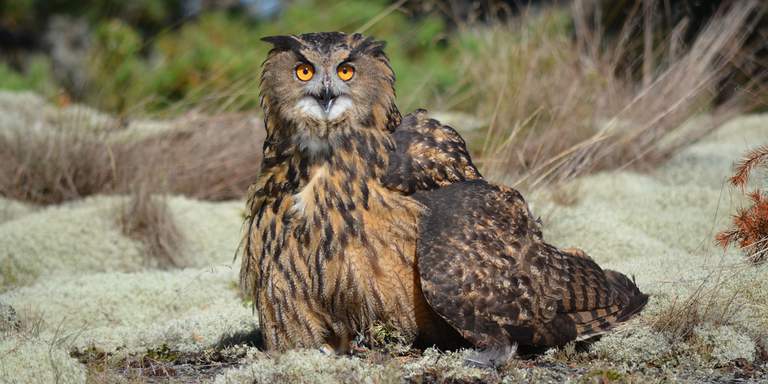Meet the animals of Stockholm
Publiceringsdatum: 23 August 2024
In the mood for a hike in the forests of Stockholm? Here are some of the city's four-legged and winged inhabitants that you might encounter.
Stockholm has some truly wild residents. Some, you can meet during a visit to Skansen. Here you’ll meet primarily Swedish species; wolves, bears, seals, moose, and wolverines to name a few. If you're curious to meet more exotic animals, step into the jungle at Skansen Akvarium or into the ocean at Haga Ocean.
Others are found in the wild; around smaller lakes and Mälaren, among the islets of the Stockholm Archipelago and the lush green forests surrounding the greater Stockholm area. Simply strolling around the suburbs of Stockholm gives you a good chance of running into a jackrabbit or roe deer.
Having the benefit of “allemansrätten” (Sweden’s right to roam) you’re of course free to grab a backpack, a coffee thermos, and venture out into the forests or archipelago to discover the wildlife on your own. We asked Didrik Vanhoenacker, biologist on-call at the Swedish Museum of Natural History, about what kind of animals to expect in Stockholm.
What can be said about the wildlife of Stockholm, in general?
"Large cities like Stockholm are full of buildings, cars, people, and dogs, which is something wild animals must adapt to. But there are also a lot of good hiding places and food sources, which makes it appealing for animals. The fact that Stockholm has lots of lush parks and many bodies of water also makes an impact on the city’s wildlife."
Are there any species that are only found in Stockholm?
"No, not really. I’m sure certain weeds have only been found in Stockholm, and maybe some unintentionally imported bugs and insects. Otherwise, the animals found in the city as the greater Stockholm area are the same. The most important environment in Stockholm for rare species are the old oak trees in the Royal National City Park."
Which are the newest species to have found their way to Stockholm?
"Nowadays, you can actually spot beavers in the city. They were extinct in Sweden just 100 years ago. Wild boars were also extinct, but are now found in the suburbs and surrounding areas of Stockholm. Looking at bugs and insects, the oak bush cricket and Roesel's bush cricket are two fairly new species in Stockholm, already becoming more and more common. One species that probably could establish itself here is the peregrine falcon. It already nestles in many other Swedish cities."
In the fall you can also hear the mating sounds of the particolored bat, “zzitt”, as it bounces off the face of tall buildings.
Famously, the small Lessertia dentichelis-spider thrives on the moss-covered walls of Kungsträdgården’s subway station. Are there more examples of animals that nest in odd places?
"Many types of birds nestle on rooftops, most notably seagulls. But also oystercatchers and eagle-owls. In the fall you can also hear the mating sounds of the particolored bat, “zzitt”, as it bounces off against the face of tall buildings."
In Sweden, there’s something called “landskapsdjur”, an official provincial animal for lack of a better word. Depending on which part of Stockholm you’re in, the provincial animal is either the Osprey or the white-tailed eagle. Do you have any tips for bird watchers wanting to catch a glimpse of them?
"You have quite a good chance of spotting white-tailed eagles at Strömmen and Skeppsbron during winter. Odds are even better if you take a boat out to the Archipelago, in the summer as well. The best chance of spotting osprey is when they migrate in April and August, for example, if you look out from Skinnarviksberget at Söder. Osprey can also be found in many of the lakes in the surrounding areas."
Are there any parks or areas especially good if you want to get up close with the animals of Stockholm?
"The whole area of Djurgården is beautiful and rich in species with its old oaks and leaf trees and you’ll also find Isbladskärret on Djurgården, a small but excellent lake for bird-watching. Råstasjön and Lappkärret, both reachable by subway, are also great. During winter there are many types of waterfowl found at Strömmen in central Stockholm and, if you’re lucky, white-tailed eagles, maybe even grey seals. Beavers can be spotted at Årsta lake or Karlbergskanalen."
Which nature-related museums and attractions would you recommend, besides The Museum of Natural History?
"Skansen with their living animals, and Fotografiska when they have an exhibition on wildlife photography. Edvard Andersson’s conservatory at the Bergius Botanical Garden is exceptional during early spring when their Mediterranean plants and flowers are in bloom."
Petting zoos in Stockholm
Many parks around Stockholm have public petting zoos where you can meet some of our most common farm animals; goats, pigs, chickens, and rabbits for example. Like all children’s parks, or “parklekar” in Swedish, these petting zoos are staffed, open all year round, and admission free. Parklekar can be found all over Stockholm and its suburbs. There’s Blecktornsparken, Bandängens Parklek, and Parkleken Starrmyran to name a few.
